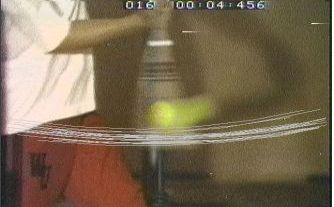show advanced search
-
41-60 / 430
- display number
-
order by date
-
order by researcher's name
-
order by affiliation
2013-0130-15
Life sciences
posted:2014/05/21
Evaluation of comfort through measurement of brain activity
KUMANO, Hiroaki Professor (Faculty of Human Sciences School of Human Sciences)
By measuring blood flow in the brain in real time through optical topography (NIRS), we can provide an objective, numerical index of the state of comfort or emotions. This will assist in the search for more effective stimulatory conditions and designs.
2013-0130-14
Life sciences
posted:2014/05/21
The brain mechanism that handles operational errors and motor learning
MASAKI, Hiroaki Professor (Faculty of Sport Sciences School of Sport and Sciences)
The activity of the anterior cingulate cortex is measured from the error-related negativity. The process of learning though warnings and rewards is analyzed through brain waves, brain imaging, TMS (transcranial magnetic stimulation), eye-trackers, etc.
2013-0130-13
Life sciences
posted:2014/05/21
Sports and sleep
UCHIDA, Sunao Professor (Faculty of Sport Sciences School of Sport and Sciences) (retired)
Regarding the effect of physical exercise on sleep at night, we carry out research into the kind of exercise that is appropriate for improving sleep.We carry out research into the potential of exercise in treating depression, to see if it can improve people’s mood.
2013-0130-12
Life sciences
posted:2014/05/21
The scientific basis and the future possibility for ischemic resistance training
TAKARADA, Yudai Professor (Faculty of Sport Sciences School of Sport and Sciences)
Takarada et al. have previously shown that low-intensity resistance exercise combined with vascular occlusion induces a marked hypertrophy and concomitant increase in strength, even if the exercise load is much lower than that expected to induce muscular hypertrophy.
2013-0130-11
Life sciences
posted:2014/05/21
Analyzing sports skills
KANOSUE, Kazuyuki Professor (Faculty of Sport Sciences School of Sport and Sciences) (retired)
In batting and pitching, a variety of analyzing methods such as the use of full body motion capture and force plates to analyze physical performance, bat swings or ball spin, and precision measuring of hand and finger movements and visual cognitive motion are used to evaluate ...
2013-0130-10
Life sciences
posted:2014/05/21
Coaching skills based on body image research, and sports promotion activities based on them
KANOSUE, Kazuyuki Professor (Faculty of Sport Sciences School of Sport and Sciences) (retired)
We are measuring and analyzing brain activity during “body imaging” in which people recall movements without actual physical movement, and the gap between what people consider to be the ideal movement and reality. Noninvasive brain imaging and biomechanical measurements are ca...
2013-0130-09
Life sciences
posted:2014/05/21
Elucidating the state of health problems centered on backaches, and proposing methods of prevention (exercise treatment)
KANEOKA, Koji Professor (Faculty of Sport Sciences School of Sport and Sciences)
We are elucidating the mechanisms behind injuries in the back region, including the spine and surrounding areas (hip joint, groin region, shoulder girdle), and we have knowledge in diagnosis, treatment and prevention. We target mainly swimmers (swimming, water polo, diving, sy...
2013-0130-08
Life sciences
posted:2014/05/21
Evaluating sports equipment based on knowledge in sports medicine
FUKUBAYASHI, Toru Professor (Faculty of Sport Sciences School of Sport and Sciences) (retired)
Analyzing through observation of the dynamics of bones and joints using cineradiography, and evaluating making use of knowledge in sports medicineSports we target mainly are soccer (junior and women’s), judo, basketball, rugby, golf, etc.
2013-0130-07
Life sciences
posted:2014/05/21
Preventing external injuries and rehabilitation centered on the knee joint
FUKUBAYASHI, Toru Professor (Faculty of Sport Sciences School of Sport and Sciences) (retired)
We are elucidating the mechanisms behind external injuries to the knee joint (ligament, hamstring muscle, etc.), and we have knowledge in diagnosis, treatment, rehabilitation and prevention.
2013-0130-06
Life sciences
posted:2014/05/21
Voice synthesizing technology based on human vocal cords
HONDA, Masaaki Professor (Faculty of Sport Sciences School of Sport and Sciences) (retired)
Analyzing the mechanical and acoustic mechanisms in the generation of voice in communicationAnalyzing the feedback from the sense of hearing and touch to the vocal system, and elucidating the mechanism for generating the quality of voice in emotional or ill people.
2013-0130-04
Life sciences
posted:2014/05/21
Deficient DNA damage response and progeria
CHIBA, Takuya Professor (Faculty of Human Sciences School of Human Sciences)
Through the functional analysis of multiple proteins involved in the copying, repair and recombination of DNA identified as being the genetic cause of progeria, we are carrying out research into the breakdown and accelerated aging of the mechanism that maintains genomic homeos...
2013-0130-03
Life sciences
posted:2014/05/21
Technology for screening anti-aging substances
CHIBA, Takuya Professor (Faculty of Human Sciences School of Human Sciences)
We have established a system of using cultured cells for screening and transgenic mice to examine and evaluate substances that have the equivalent effect in anti-aging as calorie restriction. Pro-longevity transcription factor binding sites (DFCR-RE: dwarfism and calorie restr...
2013-0130-05
Information Communication
posted:2014/05/21
Turning sports movies into a database, and automatic generation, operations analysis and strategy analysis of secondary movies
HONDA, Masaaki Professor (Faculty of Sport Sciences School of Sport and Sciences) (retired)
Sports movie databases that can be processed on computers (mainly soccer)Developing technology for automatic recognition of tournament movies and the movement of players, the ball, etc., kinematic analyses of hand and leg movements, developing statistical methods of predicting...
2013-0130-02
Information Communication
posted:2014/05/21
Bulletin board for notifying the location of people (DoorMSNGR) (developed independently)
HATAKEYAMA, Takuro Professor (Faculty of Human Sciences School of Human Sciences) (retired)
● Research phase: Applied developmental research, research into practical application and commercializationA bulletin board that allows easy, remote operation (during a meeting or while on a domestic or international business trip) through a smartphone to display the location,...
2013-0130-01
Information Communication
posted:2014/05/21
A note-taking support system for enhancing the feeling of participation in lectures by hearing impaired students
HATAKEYAMA, Takuro Professor (Faculty of Human Sciences School of Human Sciences) (retired)
● Research phase: Applied developmental research, research into practical application and commercialization. Digital pen technology called Anoto, developed in Sweden, and a presentation system (OpenSTAGE®) developed by Dai Nippon Printing Co., Ltd. have been used in the suppor...
2012-1029-03
Environment
posted:2014/05/21
Development of cleaning agents for water and soil using inorganic materials
MATSUKATA, Masahiko Professor (Faculty of Science and Engineering School of Advanced Science and Engineering)
We have highly economical insolubilization technology for treating polluted soil, and water treatment technology for dealing with all toxic metals.
2012-1029-02
Environment
posted:2014/05/21
Research into inorganic separation membranes
MATSUKATA, Masahiko Professor (Faculty of Science and Engineering School of Advanced Science and Engineering)
■ Compared to traditional processes that make use of phase changes such as cryogenic separation, the separation process through a zeolite membrane enables energy savings. As shown in Fig. 1, zeolite has a separation function that makes use of differences in molecular size and ...
2012-1029-01
Energy
posted:2014/05/21
Synthesis of Ordered Porous Materials and Catalytic Chemical Applications
MATSUKATA, Masahiko Professor (Faculty of Science and Engineering School of Advanced Science and Engineering)
■Research on micro- and mesoporous materialsA precursor gel is once dried, and this is then crystallized in the vapor phase. The use of the DGC method allows the preparation of zeolites with structures and compositions not obtainable by the hydrothermal synthesis method. The L...
2012-1019-01
Nanotechnology / Materials
posted:2014/05/21
Fabrication of Nanoparticle Phosphor Film and Solar Cell Applications
KOBAYASHI, Masakazu Professor (Faculty of Science and Engineering Waseda Research Institute for Science and Engineering)
Our laboratory made nanoparticle phosphors of several nm using the ball mill method. Transparent thin film with over 90% transmittance in all wavelength regions was fabricated using nanoparticle phosphors.Red phosphor transparent thin film that meets the following conditions i...
2012-1001-08
Environment
posted:2014/05/21
Research on Semi-Volatile Organic Compounds (SVOCs) in Indoor Spaces
TANABE, Shinichi Professor (Faculty of Science and Engineering School of Creative Science and Engineering)
Our laboratory is developing a new nozzle to collect house dust, and carries out analyses of the concentrations of SVOCs in house dust. Measurements are taken not only at general residential homes, but also in various spaces, such as homes made of natural materials and kinderg...













